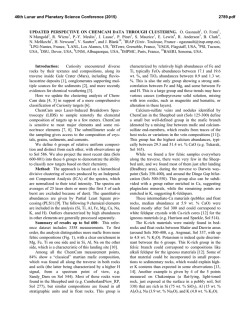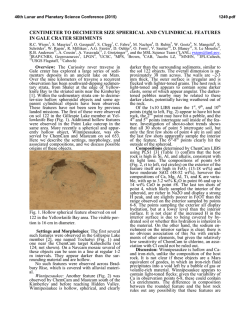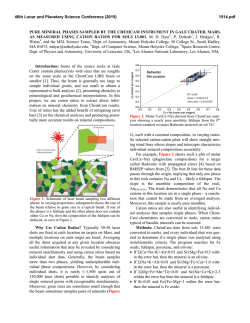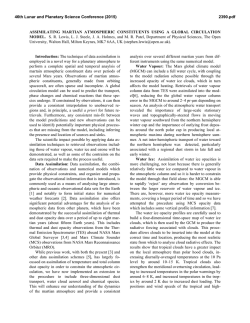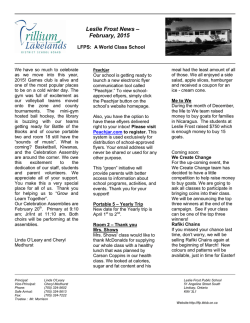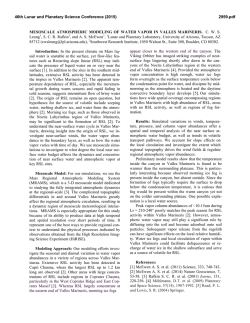
Atmospheric Condensation in the Mars Phoenix TECP and MET Data
46th Lunar and Planetary Science Conference (2015) 2861.pdf ATMOSPHERIC CONDENSATION IN THE MARS PHOENIX TECP AND MET DATA A. P. Zent, MS 245-3 NASA Ames Research Center, Moffett Field, CA 94035 ([email protected]) Introduction: A new calibration function for the humidity sensor in the Thermal and Electrical Conductivity Probe (TECP), a component of the Microscopy, Electrochemistry, and Conductivity Analyzer (MECA) on the Phoenix Mars mission has been developed. The data is now cast in terms of Frost Point (Tf) and some flight data, taken when the atmosphere is independently known to be saturated, is included in the calibration data set. Combined with data from the Meteorology Mast air temperature sensors, a very sensitive detection of atmospheric saturation becomes possible (Figure 1). Discussion: Overnight, the Mars atmosphere saturated with respect to water vapor, particularly late in the mission. On several sols, the TECP captured data during this event. For all atmospheric temperatures, we report only values from the uppermost thermocouple on the 1-meter meteorology mast (total height ~ 1.9), which we refer to as Tair. Heating from the lander deck and instruments can affect data from the other thermocouples under some wind regimes, whereas fluid dynamics calculations indicate that temperatures at the top of the mast are minimally affected [1]. Generally the atmosphere cools rapidly, and around 2400h or earlier reaches saturation At that time, two things can be seen in the data. First, on most nights after ~ sol 50, there is an inflection in the Tf data; that is, ∂Tf/∂t changes when saturation is reached. Tf tracks Tatm, but is generally a few degrees warmer, a point which will be addressed below. Secondly (also after sol 50), Tatm exhibits excursions of up to 6K upon reaching Tf, accompanied by a sharp increase in variance that persists for 1 -2 hours. The fact that changes the independent TECP and MET data occur essentially simultaneously, and at the point that the atmosphere cools to the frost point, leaves little doubt that the instruments are responding to saturation of the atmosphere and the beginnings of H2O condensation/deposition. This is grossly consistent with the LIDAR observations of surface-based clouds forming near 0000h [2]. The combined TECP and MET data provide strong support for the argument [3] that the Viking landers detected the signature of atmospheric saturation in air temperature measurements. The Viking landers did not have an instrument designed to detect atmospheric water vapor. However, during the night, the observed rate of decline of the atmospheric temperature at the 1.6-m height of the meteorology boom decreased for a period of about an hour and then resumed its original value. Based on the behavior of this inflection and the detection of enhanced atmospheric opacity at night Ryan and Sharman [3] interpreted the nighttime tem- perature inflection to be a radiative effect due to the formation of an ice fog and thus the result of atmospheric saturation and condensation of water vapor. In Figure 2, the air temperature data from VL1 (Sol 21) is plotted along with the MET and TECP data for the evening of Sol 70. The Viking data are at a much lower frequency (~ 8 minute intervals) than the MET data, and miss the high frequency signal. The inflection occurs later (near 0200h v. 2300h for PHX) and at lower temperature (191 K, v. 200 K for PHX), but the similarity of shape and magnitude of the two curves suggests a commonality, which we argue is the detection of the frost point. The TECP-MET data indicate that the base of the atmosphere was regularly saturating at night by sol 47. Ice fogs were observed as early as sol 38, [4] but LIDAR did not begin to reliably detect ground fogs until ~ sol 80. This is not necessarily an inconsistency, since the TECP-MET measurements were made at ≤ 2 m elevation, while the LIDAR was limited to measurements at heights >50 m due to transmitter/receiver overlap. SSI observations of the LIDAR beam include scatter from atmospheric aerosols below 200 m, and allow recovery of the ice water content (IWC) of fogs [5]. Ice fogs were detected as early as sol 61 using this approach, which was the first observation of its kind. Thus, the TECP and LIDAR data are consistent with saturation beginning much earlier in the mission than sol 80. Models of cloud microphysics in the martian environment typically require supersaturation of 10 – 20 % in order to initiate nucleation. From our data alone, it is not possible to distinguish between cases where: a) there is no supersaturation and Tf is the actual condensation temperature, and b) supersaturation is required, such that the actual frost point of the atmosphere is somewhat lower than the measured Tf. However, a sample calculation of both cases for sol 70 demonstrates that the resulting uncertainty in the partial pressure of H2O is ≤ 0.1 Pa. With respect to the coldest overnight hours, where Tf is seemingly several K warmer than Tair, Figure 2 makes it clear that Tf is pegged to Tb, the internal temperature of the TECP, for a period slightly in excess of 1.5 hours centered about 0100h. A reasonable inference is frost condensation inside the TECP housing; the instrument was designed to allow equilibration between ambient and internal H2O vapor, so this would not be a totally surprising outcome. Measured Tf values do not reflect the ambient conditions if ice is present in the TECP housing, but Tb and Tf diverge by 0200h, indicating the ice is short-lived. 46th Lunar and Planetary Science Conference (2015) There appear to be complementary excursions in Tair, both of which initiate at the time Tair reaches Tf ; in the present case a positive signal at ~2230h and a negative deviation just before 0400h. The short term variance in Tf also changes more or less commensurately with both intersections with Tair; variance decreases after 2300h, and increases again after 0400h. It is possible to draw a simple continuum through the Tair curve and numerically integrate the area of the signal to estimate the heat associated with this processes. The two areas in Figure 2 are the same to within 5%, and indicate an average absolute ΔTair of just over 4 K in both cases. This appears to require far more energy than would be available from latent heat if ice were condensing directly on the thermocouple (see [3]; the numerical values in the Phoenix case are of the same order as their analysis of the Viking data). The highest Tf measured by TECP occurs in the early morning (~0700h) on Sol 80 and later [6]. Given the possibility of overnight condensation in the TECP housing, one must question these maxima. Generally, as on sol 70, Tf follows the internal temperature after saturation. The frost point diverges from the TECP temperature sometime between 0100-0400h, indicating that ice is no longer present in immediate proximity to the humidity sensor. However, Tf > Tair for another few hours. During this interval Tf continues to increase in a smooth and continuous manner, indicating that ice continues to control the humidity, but there is uncertainty whether the ice is in the ambient, or some relatively cold corner of the TECP housing. The MET and Solid State Imager (SSI) data are consistent with the former. After ~ sol 80, clouds, and to an unspecified extent ground fog, remained through the early morning hours [2]. In addition, the length of the fall streaks indicated that the ice crystals had fall speeds that are consistent with prolate ellipsoids with volume-equivalent radii of 35 µm, similar to terrestrial cirrus clouds (i.e. fall velocities will be several cm s-1). LIDAR suggests [1, 4] somewhat smaller particles for the fog (~ 20 µm), but even these should fall at ~ 1 cm s-1. Thus, small quantities of ice are expected on the surface early in the morning. Calculations of ~ 4 pr µm on the surface [7] on the morning of sol 100, and ~ 2.5 pr µm on sol 113 [5] have appeared in the literature. Since the surface will begin warming before the PBL is fully convective, the morning Tf maxima may result from sublimation of that surface ice and the subsequent decrease in Tf would reflect the onset of convective instability that mixes the near-surface vapor back into the PBL. A causal relationship with precipitation of fog aerosols would likewise explain why early morning humidity peaks do not occur prior to the regular appearance of nighttime fogs. 2861.pdf As for the frost point apparently exceeding the air temperature, this may well demonstrate a limitation in our assumption that the MET sensor represents the temperature of the air around the TECP; at the time of the measurements, the TECP was about 50 cm closer to the surface than the MET sensor, and just over 3 meters to the northeast, on the opposite side of the lander body (Fig. 1). References: [1] Davy, R. J. et al., 2010. J. Geophys. Res., 115, E00E13, doi:10.1029/2009JE003444; [2] Whiteway et al., 2009, Science, 325, 68 – 70; [3] Ryan and Sharman, 1981, J. Geophys. Res., 86, 503-511. [4] Dickinson, C., et al., 2010. GRL, 37, L18203, doi:10.1029/2010GL044317. [5] Moores et al.; 2011, GRL., 38, L04203, doi:10.1029/ 2010GL046315. [6] Zent, A. P. et al., 2015, Submitted to: JGR, [7]. Daerden, F., et al. 2010. GRL, 37, L04203, doi:10.1029/2009GL041523. Figure 1. Relative positions of the MET mast atmospheric temperature transducer and the atmospheric H2O sensor on the TECP. Figure 2. Sol 70. Simultaneous excursions in frost point (blue circles) and air temperature (black line) at around 2300h. Red cicrcles are the TECP internal temperature. Grey circles record similar phenomenon at VL1.
© Copyright 2025

